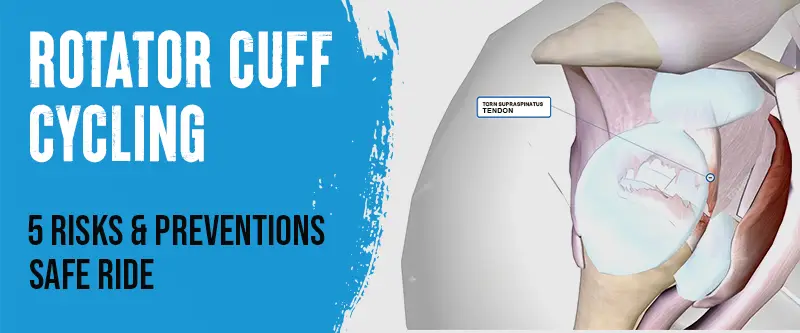The rotator cuff is a group of muscles surrounding the shoulder joint, securing the upper arm bone’s head within the shoulder’s shallow socket. Injuries to the rotator cuff can cause dull shoulder aches that worsen at night.
Yes, a bike can be ridden with a torn rotator cuff. It is not recommended. Riding your bike while injured can cause more damage to the rotator cuff and may even require surgery. If you do choose to ride your bicycle with a torn rotator cuff, be sure to take into account the amount of pain you will be in and the risk of further injury.
We will discuss the anatomy of the rotator cuff, the risk factors for rotator cuff injuries in cycling, and preventative measures for rotator cuff health.
Rotator Cuff Cycling: 5 Real Risks You Need to Know

Cycling keeps you fit and healthy but can also strain your shoulders. The rotator cuff connects four muscles to stabilize the shoulder joint. Cycling frequently or for extended periods may increase your risk of injuring your rotator cuff. Here are some of the common cycling-related risk factors:
Repetitive Motion of the Shoulder
The rotator cuff is often injured from repetitive motion of the shoulder. When you cycle, you must keep your arms fixed and apply force to the handlebars. You can overuse and inflame your rotator cuff tendons significantly if you do not change your hand position or grip often.
Repetitive motion can also cause micro-tears in the rotator cuff tissues, weakening them over time and making them more prone to injury.
To prevent repetitive motion injuries, you should:
- Vary your hand position and grip on the handlebars.
- Use padded gloves and tape to reduce friction and vibration.
- Take breaks and stretch your shoulders during long rides.
- Avoid riding in cold or wet weather, as it makes your muscles stiff and tight.
Poor Posture and Overuse
Another risk factor for rotator cuff injuries is poor posture and overuse. Suppose you have a bad posture while cycling, such as hunching your back, rounding your shoulders, or leaning too far forward. You can put extra pressure on these muscles and tendons.
Poor posture can also affect your breathing, blood circulation, and spinal alignment, impairing your performance and recovery. Moreover, if you cycle too much or intensely without adequate rest and healing, you can exhaust your rotator cuff muscles, making them more susceptible to injury.
To avoid poor posture and overuse injuries, you should:
- Adjust your bike fit and equipment to suit your body type and riding style.
- Maintain a neutral spine and shoulder position while cycling.
- Use your core muscles to support your upper body and reduce shoulder strain.
- Follow a balanced training program that includes rest days and cross-training.
- You should stop cycling if you feel pain or discomfort in your shoulder.
Incorrect Bike Fit and Equipment
A third reason for rotator cuff injuries is incorrect bike fit and equipment. If your bike is too big, too small, or not correctly adjusted, you can end up in an awkward or uncomfortable position that can stress your rotator cuff.
For example, if your handlebars are too low, too high, too close, or too far, you can strain your shoulder muscles and tendons by reaching or bending too much.
Similarly, if your saddle is too low, too high, too forward, or too backward, you can affect your pedaling efficiency, balance, and shoulder stability.
To ensure the correct bike fit and equipment, you should:
- Get your bike fitted by a professional, or use a bike-fitting guide.
- Choose a bike that matches your height, weight, and riding level.
- Adjust your handlebars, saddle, stem, and pedals to optimize comfort and performance.
- Use a bike computer, GPS, or smartphone to monitor your speed, distance, and cadence.
- Replace your bike parts and accessories regularly to avoid wear and tear.
Lack of Warm-up and Stretching
A fourth cause of rotator cuff injuries is a lack of stretching and warm-up. If you start cycling without warming up your muscles and joints, you can increase your risk of injury by causing sudden or excessive stress on your rotator cuff.
Warming up helps to increase your blood flow, oxygen delivery, and flexibility, which can prepare your body for cycling and prevent injuries.
Stretching after cycling helps relax your muscles, reduce tension, and improve your range of motion, preventing stiffness and soreness in your shoulder.
To benefit from warm-up and stretching, you should:
- Do a dynamic introduction before cycling, such as arm circles, shoulder rolls, and neck rotations.
- Cycle at a low to moderate intensity for 10 to 15 minutes before increasing your speed or intensity.
- Do static stretching after cycling, such as shoulder, chest, and upper back stretches.
- Stretch each line for 15 to 30 seconds and repeat twice.
- Avoid bouncing, twisting, or overstretching your shoulder while stretching.
Here are some rotator cuff shoulder pain exercises include:
Pectoral stretch: Lift your shoulder and elbow to 90 degrees using a corner or a doorframe. With your forearm flat, stand in line with the wall and gently lean forward, rotating away from the wall if required. Hold for 30 seconds. On the other side, gently release and repeat.
Overtraining and Training Errors

A fifth cause of rotator cuff tears is overtraining and training errors. If you cycle too often, lengthy or complex, you can overload your rotator cuff muscles and tendons and cause them to break down.
Overtraining can also lead to fatigue, inflammation, and reduced immunity, impairing healing and recovery. Training mistakes like increasing your mileage or intensity too quickly, cycling on uneven or rough terrain, or using improper technique can also put undue stress on your rotator cuff.
To avoid overtraining and training errors, you should:
- Follow the principle of progression, which means gradually increasing your mileage, intensity, and cycling frequency.
- Follow the principle of specificity, which means cycling according to your goals, abilities, and preferences.
- Follow the principle of variation, which means changing your cycling routine, routes, and challenges to avoid boredom and plateaus.
- Follow the principle of recovery, which means taking enough time to rest, sleep, and hydrate between cycling sessions.
- Follow the principle of feedback, which means listening to your body and adjusting your cycling plan accordingly.
Rotator Cuff Injuries Symptoms
Shoulder pain, a prevalent issue affecting cyclists of all ages and activity levels, often manifests through typical symptoms linked to rotator cuff injuries.
Shoulder Pain
Pain in the shoulder is a hallmark symptom of rotator cuff injuries. It may occur during specific movements, such as reaching overhead or out to the side, and can also be present at rest.
People with rotator cuff injuries often experience increased pain, particularly at night when trying to sleep on the affected shoulder. Depending on the severity of the injury, there may be dull pain or sharp discomfort.
Muscle Weakness
Weakness in the muscles surrounding the shoulder, especially when lifting objects or reaching overhead, is a common symptom of rotator cuff injuries. Muscles of the rotator cuff play a crucial role in stabilizing and controlling shoulder movements,
As a result, weak muscles in these areas can make daily tasks requiring arm strength difficult. A person may notice a decrease in their ability to lift, carry, or perform activities involving shoulder use.
Popping or Clicking Sensations
Some people with rotator cuff injuries may experience audible or sensory feedback such as popping, clicking, or grinding sounds when moving their shoulder. These sounds can occur during specific movements or throughout a range of motion, showing potential damage or impingement within the shoulder joint.
While not always painful, these sounds may concern and warrant further evaluation by a healthcare provider.
Limited Range of Motion
Another prevalent symptom of rotator cuff injuries is a limitation of shoulder mobility. Many people may find it challenging to move their shoulders in specific directions, such as lifting the arm overhead, reaching behind the back, or rotating the arm externally or internally.
This limitation in motion can impact daily activities, sports performance, and overall quality of life, prompting patients to seek treatment to improve shoulder mobility and function.
Considerations For Mountain Biking After Rotator Cuff Surgery
Recurring pain, particularly during specific activities, can hinder sleeping on the affected side. Audible grating or cracking when moving the arm and restricted arm movement are concerning signs post-rotator cuff surgery. Delving into biking after such a procedure demands thoughtful examination. Let’s delve into the specifics:
Rotator Cuff Surgery
- Rotator cuff surgery is commonly performed after injuring one of the rotator cuff muscles.
- The surgery aims to repair torn tendons or muscles in the shoulder.
- Recovery from rotator cuff surgery is complex and lengthy, but with proper guidance, it can be successful.
Healing Time
- Typically, you can expect to return to activity within 6-12 months after rotator cuff surgery.
- Your physical therapist will play a crucial role in guiding your post-operative progression. You can also try Yoga poses to relax your muscles.
Stationary Recumbent Bike
- You can usually use a stationary recumbent bike two weeks after surgery.
- This allows you to start cardio while keeping your shoulder safely in a sling.
Spin Bike or Upright Stationary Bike
- You can start using an upright stationary bike or spin bike 12 weeks after surgery.
- Your physical therapy exercises will have progressed, allowing weight-bearing activities through your shoulder.
Mountain Bike Anatomy
- A mountain bike relies on each of its components to function effectively. Our guide outlines the diverse elements that constitute a modern mountain bike. Depending on the rider’s style or the manufacturer, some components mentioned may be referred to by a different name or fall into another category.
Rotator Cuff in Cycling: Anatomy
The repetitive cycling motion can stress your rotator cuff significantly, leading to pain, discomfort, and even injury. We’ll examine the rotator cuff’s anatomy and function and why maintaining its health is critical for cycling performance.
Rotator Cuff Muscles and Functions
The rotator cuff comprises four tendons and muscles surrounding the shoulder. These are:
- Torn Supraspinatus Tendon: A supraspinatus tendon tear is the tearing of the tendon linked to the supraspinatus muscle in the shoulder’s back. This tendon is prone to damage and is frequently affected. Such tears often happen alongside tears in other rotator cuff muscles, resulting from sudden injury or repetitive strain.
- Infraspinatus: Covers the lower part of the shoulder blade and attaches to the back of the arm bone. It helps to rotate the arm outward and stabilize the shoulder.
- Teres minor: This muscle is located below the infraspinatus and joins the shoulder blade to the arm bone. Stabilizes the shoulder and rotates the arm outward.
- Subscapularis: This muscle is on the front of the shoulder blade and connects to the front of the arm bone. The arm is rotated inward and stabilizes the shoulder.
Rotator cuff muscles allow for shoulder movement and keep the arm bone’s head in place. The rotator cuff tendons also form a cuff around the shoulder joint, which protects it from injury and inflammation.
The Function of the Rotator Cuff

The rotator cuff has several vital functions for cycling, such as:
- Controlling arm movements: The rotator cuff muscles enable the arm to perform various motions, such as reaching, pulling, pushing, and steering. These motions are essential for cycling, allowing the cyclist to adjust the bike’s position, balance, and direction.
- Supporting the body weight: The rotator cuff muscles also help to keep the body weight on the handlebars, especially when the cyclist is leaning forward or riding uphill. This reduces the stress on the lower back and the legs and improves the efficiency and comfort of cycling.
- Preventing shoulder injuries: The rotator cuff muscles and tendons act as a shock absorber and a stabilizer for the shoulder joint. They contain the arm bone from slipping out of the socket or rubbing against the shoulder blade, which can cause pain, inflammation, or tears.
Importance of Rotator Cuff Health in Cycling
Keeping the rotator cuff healthy and strong is essential for cycling, as it can:
- Enhance the performance: A healthy rotator cuff can improve the arm and shoulder range of motion, power, and endurance. This can help cyclists ride faster, longer, and more smoothly.
- Reduce the risk of injury: A healthy rotator cuff can prevent overuse, fatigue, and damage to the shoulder tissues. This can help cyclists avoid common shoulder problems, such as tendinitis, bursitis, impingement, or tears.
- Increase enjoyment: A healthy rotator cuff can eliminate the shoulder’s pain, stiffness, and weakness. This can help the cyclist to enjoy the ride more and to recover faster.
Conclusion
Rotator cuff injuries are a common issue that can occur in cycling due to the repetitive motion of the shoulder. Understanding the risk factors associated with it is crucial to staying healthy.
You can avoid the risk of rotator cuff injuries by taking proper preventative measures like formal training and conditioning, appropriate bike fit and equipment, adequate warm-up and stretching, good nutrition and recovery, rest, and rehabilitation.
Remember, prevention is always better than cure, and taking care of your body is essential to continue enjoying your cycling sessions for years to come. So, get on your bike, but remember the importance of taking the necessary precautions to keep your rotator cuff healthy and injury-free.
FAQs
What Causes My Shoulder to Hurt After Riding My Cycle?
Neck and shoulder pain frequently afflict cyclists. One of the primary culprits is an ill-fitted bike, particularly when it comes to being overly stretched out or positioned too low. Improving the bike fit can alleviate these issues and enhance comfort during rides.
When Can You Ride A Bike After Rotator Cuff Surgery?
Anatomic shoulder replacements can take five to six months to fully recover strength and range of motion following surgery. To support your recovery, it’s important to follow your healthcare provider’s post-operative instructions carefully and attend any recommended physical therapy sessions.
Is Cycling Bad For Rotator Cuff Injury?
Yes, cycling can cause shoulder impingement. Since cycling is an endurance sport, rides can last over an hour. As a result, the shoulders can bear a considerable amount of weight, especially for the shoulder’s rotator cuff, which is a key stabilizer.


